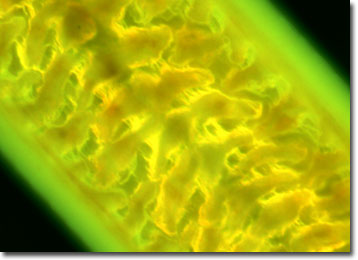Fluorescence Digital Image Gallery
Guinea Pig Hair
The guinea pig Cavia porcellus is a domesticated form of the cavy and is native to South America. It is believed to have been domesticated during pre-Incan times from a wild species that lived in Peru.

Guinea pigs are not, in fact, pigs, but are rodents, relatives of mice, rats, and hamsters. Like other rodents, guinea pigs' teeth do not have nerves and grow continuously, like fingernails. Wild guinea pigs, scientifically described as Cavia tschudii, are found in the Andes and Peru where they live in burrows and graze on vegetation.
There are several theories about why these rodents are called guinea pigs. One conjecture is that when first imported to England they were meant to be sold for a guinea a piece, and they were known as pigs due to their squealing noises. Another theory is that the word guinea is actually a corruption of Guyana, a country in South America where domestic breeds of Cavia are kept and are referred to as pigs. A third theory proposes that the name may refer to Guineamen, who were in the slave trade and may have been the first to import the animals from South America to England.
There are many types of domestic guinea pigs, most breeds recognizable by their hair type. English and American breeds have smooth short hair, Angoras have smooth long hair, and Peruvians have rough long hair. Varieties of breeds are typically distinguished by hair colors and markings. Domestic guinea pigs are still an important source of meat for some people in the Andes. The small animals are also used in a multitude of research roles including biochemical, physiological and pharmacological. In western culture, guinea pigs are regarded as docile, loveable pets. They can't be taught to roll over and fetch, but they'll lie in someone's lap for hours. A full-grown guinea pig is about 6 to 10 inches long, weighs 2 to 4 pounds, and may live for as many as 8 years.
The specimen presented here was imaged with a Nikon Eclipse E600 microscope operating with fluorite and/or apochromatic objectives and vertical illuminator equipped with a mercury arc lamp. Specimens were illuminated through Nikon dichromatic filter blocks containing interference filters and a dichroic mirror and imaged with standard epi-fluorescence techniques. The specific filter utilized for the guinea pig hair was a B-2E/C. Photomicrographs were captured with a Nikon DXM 1200 digital camera system coupled to the microscope with a lens-free C-mount adapter.
BACK TO THE FLUORESCENCE DIGITAL IMAGE GALLERY
